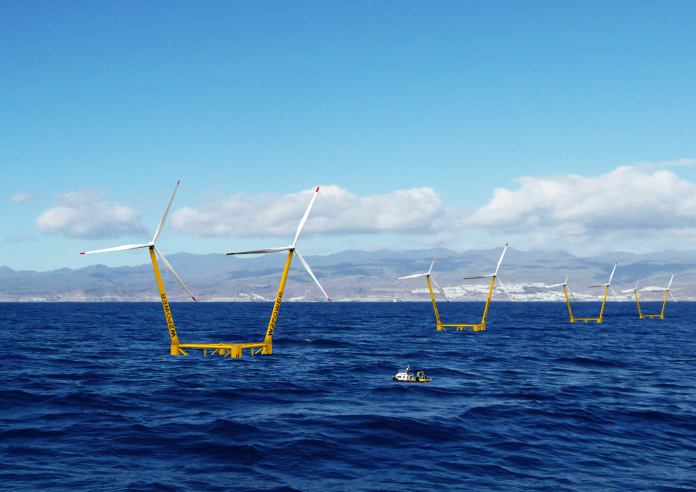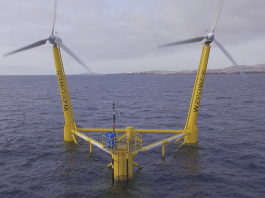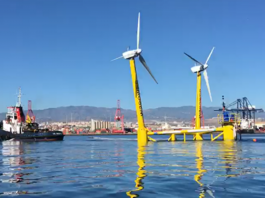Jan Hanssen, EnerOcean Co-Founder, discusses the potential that multi-use floating wind power can have at sea.
Multi-use of the ocean space is a huge trend in the blue economy. For floating offshore wind, being able to share space with other activities would accelerate growth. But most technologies are incompatible with multi-use. In this third article in a series, we explain how W2Power offers economic and environmental upside potential by its superior multi-use capabilities.
Two previous articles1,2 summarised key advantages of Enerocean’s W2Power floating wind solution and how it presents an attractive path to cost-effective offshore wind developments. A recent review paper3 compares the status of all floating wind technologies tested at sea. W2Power qualified in 2019 by our TRL 6 prototype, and today Enerocean is building a full-size demonstrator in a port, which will mark TRL 7.
The review’s authors focused on two design drivers for floating wind: stability and cost-efficiency. In the present article, noting that W2Power has reached its design goals on both essential aspects, we highlight its economic upside potential by multi-use.
We are proposing multi-use to be an added class of design drivers. This could add value to developers, investors and all stakeholders while protecting the marine ecosystem. Multi-use capabilities will become progressively more important with the rising role of maritime spatial planning (MSP). Being able to adapt to, or even facilitate, other uses of the sea space could thus become a distinguishing feature of winning technologies. Fig. 1 summarises some of the multi-use applications for W2Power, from its inception developed with multi-use in mind.
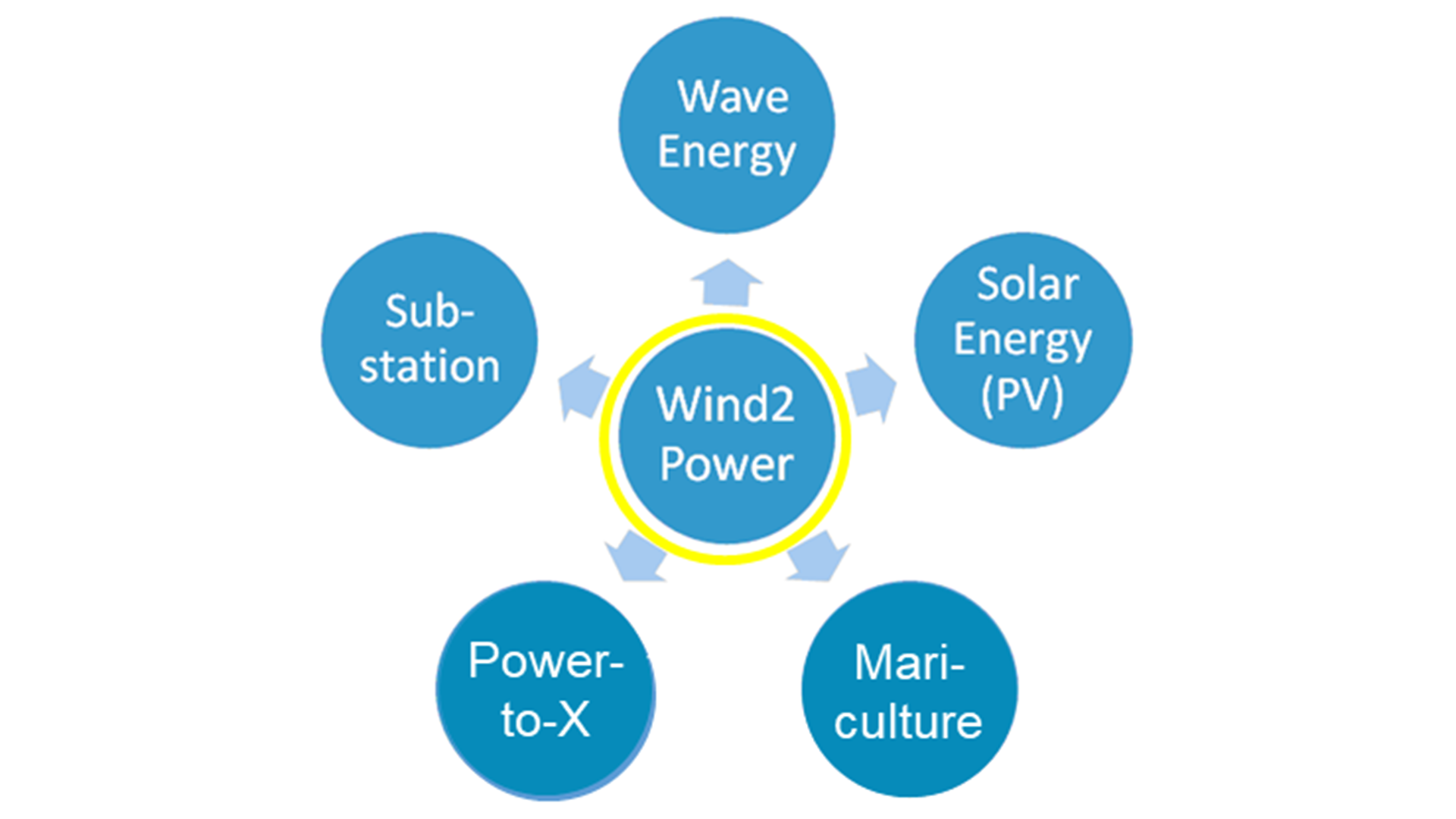
Energy multi-use
Producing electricity from an additional renewable source can give a higher capacity factor and shorter periods of low production. Solar resources at sea are uncorrelated with wind, and interest in floating solar is driven by the cost efficiency of photovoltaics. Design studies show that 350-375 kW of PV electricity may be produced on today’s W2Power.
Supporting the PV panels, cabling, and electronics on the floater lowers capital expenditure (CapEx), while less seawater corrosion reduces operational expenditure (OpEx) compared to separate floating solar. The PV power can be exported by the same cable, grid connection point and substation, or dedicated PV inverters could be kept for on-board use.
Wave resources in most deep seas are dominated by ocean swell, only weakly correlated with local winds. Therefore, wave power from a hybrid wind/wave platform could have higher market value. In addition, exploiting the wave energy was an original design goal for W2Power4 and has been a focus of research and development (R&D) using our proprietary wave energy converters. The size of the platform allows the necessary capture length for waves, while the near-symmetric configuration of the WEC arrays makes wave energy extraction largely omnidirectional.
Engineering studies for various sites show that, at best wave conditions, W2Power could yield up to 3MW from waves on top of its current industry-leading power rating of 20MW from wind. If realised, it would be the most powerful wave energy device ever built. It would also be a most economical wave energy device, because support and station-keeping for the WECs, control and export of power are provided by the platform (see Fig. 2).
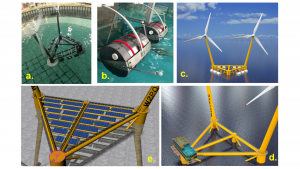
With W2Power, multi-use advantages extend also to power conditioning and export. Installing an on-board substation is an attractive option. Conventional substations offshore require dedicated fixed support, and other semi-submersible or spar-based floaters lack the space or the carrying capacity. Enerocean design studies on a lightweight, flexible modular substation type being commercialised5 show that it could be put on the bow column without massive reinforcement of the floater. Notably, this would allow continuous wind-power production from the W2Power/substation unit.
Multi-use beyond energy production
In addition to producing electricity, multi-use can include other activities at sea to further enhance the business case. These include energy storage and seawater desalination. In recent years, production of ‘green’ hydrogen by electrolysis also attracts much interest. The merit of implementing any ‘Power-to-X’ technologies offshore depends on the added costs and risks of operating at sea. The challenge is harder the more complex the process to be done offshore.
Enerocean has developed a compressed air-based energy storage process well adapted to offshore. Furthermore, we have found that using W2Power as a base for offshore mariculture is particularly attractive, as our floater design can support very large commercial fish cages.
Mariculture is farming of fish, shellfish, molluscs, and algae for human consumption. The global aquaculture market (including freshwater) was $289.6bn in 2022, which is eight times that for offshore wind, and is projected to exceed $420bn by 2030.6 The industry is seeking new technologies to improve production and reduce environmental impacts. One trend is to go offshore, allowing higher production without more pollution.7 However, so far, the missing link has been a lack of technologies to withstand the harsher conditions.
Enerocean has invented proprietary technology for anchoring very large fish cages to the floater, which offers major cost savings. Various multi-use cases were studied systematically in EU-supported R&D Enerocean participated in.8 W2Power holding a fish cage was developed to TRL 4 in tank tests and recently to TRL 6 by open-sea tests (Fig. 3). This is the first case in the world of a floating wind platform integrating a fully-functional fish cage successfully tested at sea.
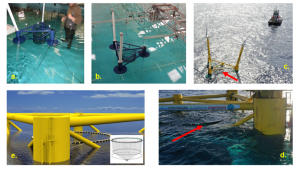
The sea tests proved all the underlying physics and engineering principles for the innovative systems for controlling the fish cage, Internal Cage Mooring (ICM) and Cage Insertion & Removal (CIR). These are not shown in Fig. 3, as they are under IP protection. The six weeks at sea included long periods with waves of equivalent load far beyond the design specifications of any free-floating fish cage. Using state-of-the-art mooring line load monitoring cells on the ICM gave loads well within the system design envelope.
At full scale, any influences of the fish cage on the floater stability are likely to be minor. These results show that the W2Power platform provides excellent stability and support to the fish cage. The costs and risks for mariculture operators of moving to offshore waters can be drastically reduced.
Cost-benefit estimation for multi-use
A methodology for assessing multi-use floating wind technologies at sea was developed earlier, using a ‘synergy equation’ for representing additional costs of integrated versus separate installations at sea.9 Based on refined versions of this, specific business cases were developed and analysed in detail for a previous W2Power (12 MW) design with a commercial very large fish cage.
Stacking density, cycles of fish raising, and growth rates from industry sources were adjusted to be conservative. Results for one major commercial and one emerging species indicate that gross revenues from sales of fish could be of the same magnitude, or even greater than, those from electricity sales, while the additional CapEx to accommodate the fish cage on W2Power were within the error margin of 5-10%.
Two obvious future challenges are to satisfy the needs of investors both in the power and mariculture sectors, and to reconcile the safe operations of fish farms with the ‘not-normally-manned’ nature of offshore wind. However, the economic upside is so significant that these are likely to be solved.
Summary
In summary, this article shows that the superior cost efficiency of W2Power can be even more competitive by realising attractive multi-use, and offers additional insight into how the use of a scaled prototype at sea can be useful as a real-life innovation platform.
References
- First article in this series, The Innovation Platform, Issue 11, September 2022
- Second article in this series, The Innovation Platform, Issue 13, March 2023
- E.C. Edwards et al.: Evolution of floating offshore wind platforms: A Review of at-sea devices, Renewable and Sustainable Energy Reviews, 183: 2023, 113416. June 2023
- J.E. Hanssen, Pedro Mayorga et al.: Design and Performance Validation of a Hybrid Offshore Renewable Energy Platform”, at 10th International Conference on Ecological Vehicles & Renewable Energies, EVER-2015, Monte-Carlo (Monaco) 31 March – 2 April 2015)
- A first of its kind: grid connection for Moray East, Siemens Energy 2 July 2020
- Vantage Research
- Lu et al. Environmental aspects of designing multi-purpose offshore platforms in the scope of the FP7 TROPOS Project, Conference Paper · Oceans Taipei, November 2014. DOI: 10.1109/OCEANSTAIPEI.2014.6964306
- Buck, B. H., & Langan, R. (Eds.). (2017). Aquaculture Perspective of Multi-Use Sites in the Open Ocean. Springer International Publishing. https://doi.org/10.1007/978-3-319-51159-7
- L. Margheritini, J.E. Hanssen, P. Mayorga: Proposed methodology for assessing cost of synergies between offshore renewable energy and other sea, presentation at EWTEC (Nantes) 2015
Please note, this article will also appear in the fifteenth edition of our quarterly publication.

